The most unpleasant symptoms in the form of itching and rashes can cause subcutaneous parasites in people of all ages. Any occupation brings many health problems due to complications. Worm species with a long incubation period of several months are especially dangerous.
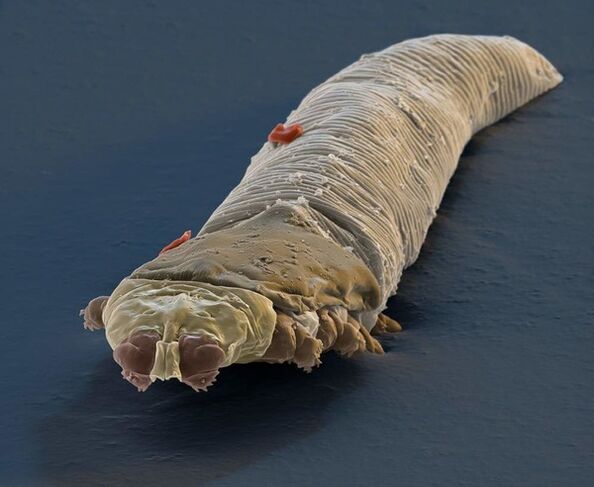
Types of parasites that live under the skin
Subcutaneous worms can enter the human body: by contact with infected people; blood-sucking insects carrying parasitic larvae from animals.
The main feature of such a fever is the difficulty in recognizing the pathology, because at first the infection can be hidden like other somatic diseases.
The parasite, which falls under the thickness of the skin, over time can spread to any internal organs and cause functional disorders. Helminths feed on blood and use it to get rid of larvae.
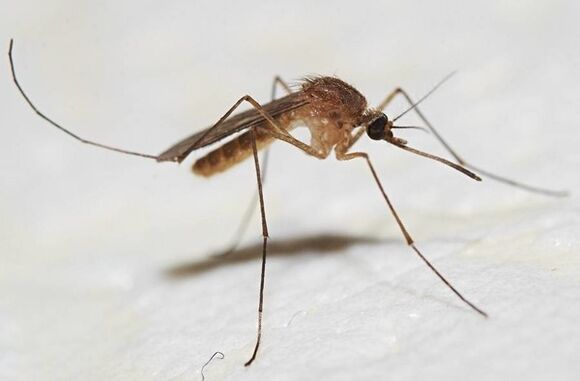
The main symptoms of this type of parasite in the body are severe weakness, decreased performance, the desire to scratch the skin. It is advisable to see a specialist when these symptoms appear: a therapist, dermatologist, allergist, infectious disease specialist. The diagnostic methods used by doctors in their joint work and work help to understand the presence of subcutaneous invasion in the body in a timely manner.
Diagnostic methods include stool, blood, scalp, and epidermal debris.
The most common infection with subcutaneous helminths occurs in countries with very hot climates - Central Asia, Africa, South America. Therefore, you should pay special attention to your health when returning from tourist trips to the continents.
It is important! It is strictly forbidden to treat yourself with medical and folk remedies - it can aggravate the condition and poison the body. It is necessary not to delay the visit to the doctor and strictly follow the prescribed course of medication.
There are many types of worms that live on the skin. The invasive species listed below are the main species.
Filariasis
Subcutaneous helminths of this species are represented by filamentous nematodes common in tropical regions. This type of parasite can live inside the skin for several years in a row, and after its adaptation, it migrates in the body and seeks another habitat.
Symptoms of the disease that initially appear are skin rashes in the form of urticaria and spots accompanied by itching. Then the temperature is added.
Symptoms of severe filariasis include eczema, ulcers and warts, subcutaneous nodules, severe headache, drowsiness, subcutaneous nodules, and increased fever.
Often, the parasite can be found at the ophthalmologist's examination because it loves to live in the mucous membrane of the eye.
It is important! When you see a doctor prematurely, filariasis contributes to the development of eye diseases and causes complete loss of vision.
Schistosomiasis
The parasite lives in warm freshwater rivers and lakes in countries with warm climates. Infection can occur while bathing or drinking raw water.
The parasite also affects the skin and urinary system. Toxins entering Ghana are highly toxic to the body, causing various disorders in many organs and systems.
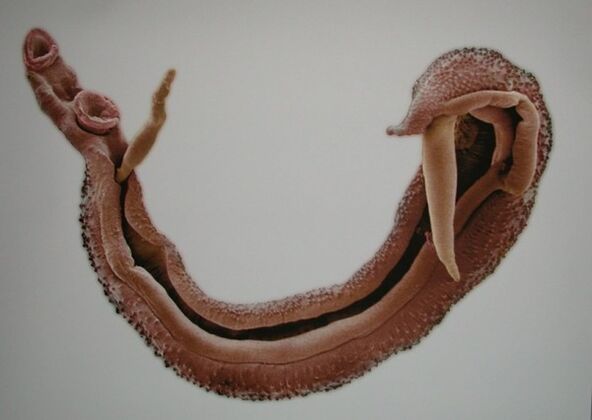
Symptoms of parasitic infection include: redness of the skin and skin in the form of dermatitis, intolerable itching, night sweats, liver enlargement, functional disorders of the renal system, a sudden rise in temperature.
Schistosomiasis, which occurs with damage to the genitourinary system, closes the outgoing and outgoing ducts of the bladder.
It is important! To avoid being infected with this helminth, you cannot swim in stagnant water bodies in the tropics and drink raw water from unknown natural sources.
Drakunkuliaz
The disease is caused by roundworms - parasites up to 80 cm in length, the infection with worms in tropical climates and Central Asian countries can be caused by the use of raw water or contact with cats. dogs that carry worms.
The incubation period from the moment of infection of the parasite's eggs and migration in the body is 1. 5 months. Parasites develop and grow throughout the year.
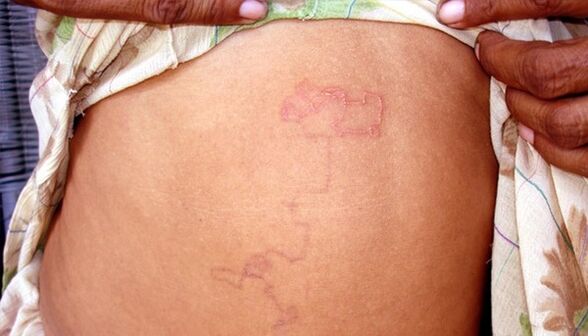
Drakunkuliaz mainly affects the skin of the lower extremities. The parasite can bend and unfold, forming a long bump on the skin and then a bubble of a few centimeters. The bubble explodes as soon as it comes in contact with water and releases the larvae, causing severe internal itching symptoms.
It is important! If left untreated with therapy and this type of parasite, a person may begin to develop sepsis, gangrenous inflammation, or joint immobility.
Don't itch
Types of ticks up to 0 mm to 4 mm are to blame for the development of itching. Parasites can be transmitted through contact with a sick person's body or if his or her immunity is severely reduced. Infection occurs when hygiene rules are not followed.
Small parasites that form on the skin first enter the epidermis, then the deeper layers and can infect the whole body with toxins. Parasites gnaw on the passages where they lay their eggs.
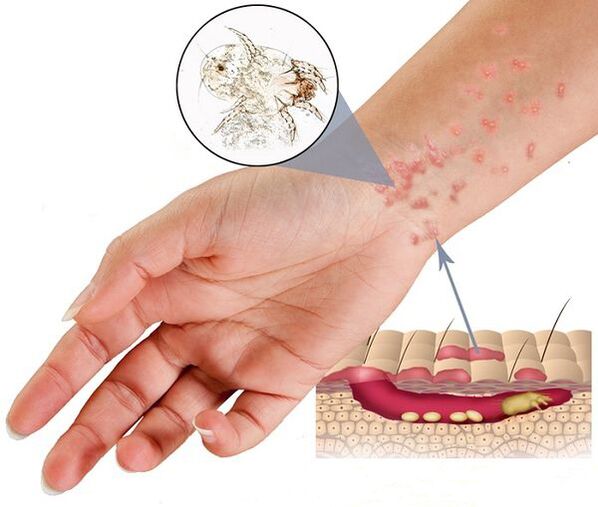
Clinical symptoms of the pathology appear in the form of red rash, small blisters and peeling of the skin: hands, thighs, elbows, knees and hair. If you treat the rash with iodine solution, then you can see ticks.
Due to the active development and reproduction of the parasite, a person suffers from unbearable itching at night, the desire to scratch the skin, as well as after contact with water.
Complications of urticaria include furunculosis, eczema, dermatitis, and vesicular lesions of the skin.
It is important! To avoid getting blackheads, you should follow the rules of hygiene and avoid contact with people infected with pruritus.
Demodectic mange
The disease, caused by a microscopic tick, is seasonal and occurs mostly in the fall. Excess oil on the skin in the spring and the negative effects of ultraviolet rays weaken the local immunity and contribute to the spread of this type of tick.
Parasites can be transmitted through contact with a sick person, as well as through the use of personal items and care items.
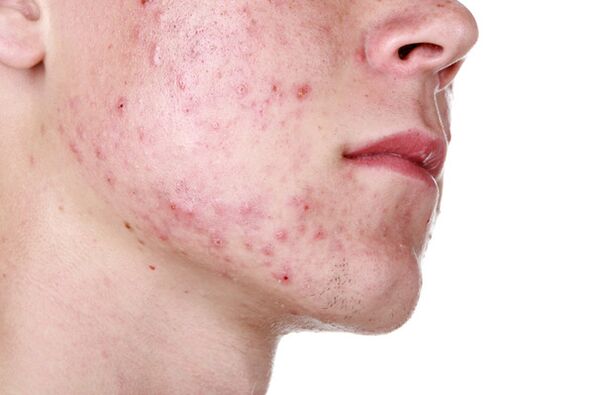
Pathological, clinical signs are very similar to acne, which occupies an increasingly large area. Pink and red papules are abundant on the face and back, leaving rough marks after healing. A person may develop inflammation of the eyelids, vasodilatation and peeling of the eyebrows.
It is important! Demodectic ego develops over the years. An itch is taken from the skin for an accurate diagnosis of a person. Healing therapy can last up to 3 months.
Dirofilariasis
Invasion is a dangerous parasitic disease caused by dirophyllous worms, which can reach 30 cm in adulthood. This type of parasite affects the subcutaneous areas as well as the eye tissue and can cause complete vision loss.
The incubation period for the development of dirofilariasis is several years. A person can be infected by mosquito bites from sick dogs and cats that carry parasitic eggs.
A seal grows on the skin, accompanied by pain, unbearable itching and hyperemia. The seal can grow to the size of an average egg inhabited by a helminth.
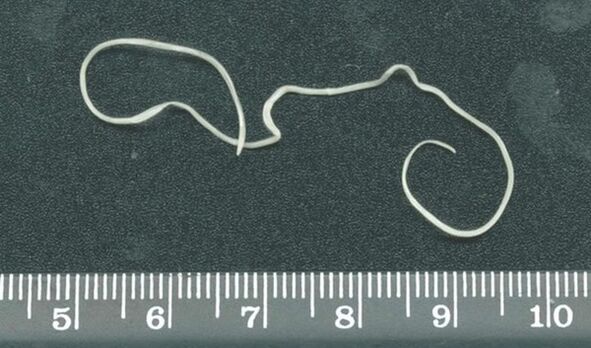
The parasite mainly lives on the skin, but can sometimes be seen, which can lead to vision loss and vision loss.
To prevent this type of worm infestation, you should fight mosquitoes by all possible means and use repellents in your daily life.
How to get rid of subcutaneous parasites?
The control of worms growing under the skin is based on the use of superficial and medicinal methods, as well as surgery.
Antiparasitic therapy for each type of helminth can be presented in the form of a table:
| Type of helminthiasis | Applied methods |
|---|---|
| Filariasis | Anthelmintic drugs for the treatment of filariasis. In severe cases, surgery. |
| Schistosomiasis | Riding and surgical methods are used. At the same time, the affected organs need to be restored. |
| Drakunkuliaz | Purchase of surgically neat worms. |
| Don't itch | Local medicines: salicylate ointments and sulfur soap; water soap suspension; hydrochloric acid solution 1 week. Immunological preparations. Thorough disinfection of the patient's clothes and household items. Sometimes antibiotics are used. |
| Demodectic mange | External agents are used: comprehensive cosmetic care (cleansing, masks, peels), hyaluronic acid, alginates in addition to camphor alcohol. Immunostimulants, vitamin complexes, anti-inflammatory drugs are used. Be sure to treat the accompanying pathologies of the digestive system and metabolic diseases. A healthy diet and physical therapy are important. |
| Dirofilariasis | Surgical treatment. It may be necessary to remove the eyeball. |
In most cases, you can get rid of subcutaneous helminths with surgery and a course of intensive chemotherapy.
Surface treatment
Surface movement techniques are used to combat helminths that live on the epidermis (eg, pruritus and demodicosis).
External antiparasitic drugs are rubbed into the skin with itching. These drugs are rubbed all over the body at night. The course lasts 2 weeks. It is recommended that those who come in contact with an infected person perform the same procedures.
With demodicosis, suspensions, ointments, solutions, gels, scrubs, cryotherapy are used, which reduce the secretion of the mammary gland, deprive food and reduce the negative effects of the parasite.
External manifestations of other types of helminths are removed with the help of ointments with steroids and antibiotics.
All ointments specially selected by doctors eliminate inflammation, deprive parasites of motor activity and kill them.
Topical procedures should be applied in moderation to avoid damage to the skin in order not to disturb the acid-base balance and to exclude the binding of pathogenic microbes to the pathology.
It is important! When starting a therapy course at a warm temperature, it is necessary to wash the laundry and warm the pillows in the bright sun.
Medications
Each type of helminth is treated with its own medication prescribed by a doctor according to the stage of the disease.
Some drugs completely kill parasites, some immobilize and prevent reproduction.
When a helminth dies, a person may experience symptoms of intoxication - headache, nausea, vomiting, so medications are carefully selected. Enterosorbents are allowed.
The main diseases are necessarily treated with pathologies of other organs. Symptomatic therapy is applied.
Surgical methods
Surgeons need to intervene to remove the parasite by incision.
The operation is usually performed under local anesthesia. A surgeon needs to be a virtuoso and a master of his art so that when removing a helminth, remove it completely without dividing it into parts.
Postoperative rehabilitation methods include therapy with antibacterial, analgesic, anti-inflammatory and antiparasitic drugs.

Prevention of infection with helminthiasis
Carefully prevent subcutaneous worms from entering the body.
Definitely need:
- to undergo annual medical examinations;
- consult a doctor for various diseases;
- wash your hands thoroughly after going to public places and touching strangers and stray animals;
- boil raw water and do not drink from natural sources;
- do not swim in stagnant pools, especially in hot countries;
- to fight blood-sucking insects using repellents and protective equipment;
- perform daily and general cleaning of the house and maintain order.
You should follow safety precautions when traveling to epidemically dangerous countries and make sure you find all the information on how to protect yourself during the trip.
It is necessary to lead a healthy lifestyle, eat well, harden and improve immunity by taking vitamin complexes several times a year.
Fighting subcutaneous parasites requires patience and effort. If all the doctor's prescriptions are followed, the person will recover completely.



























